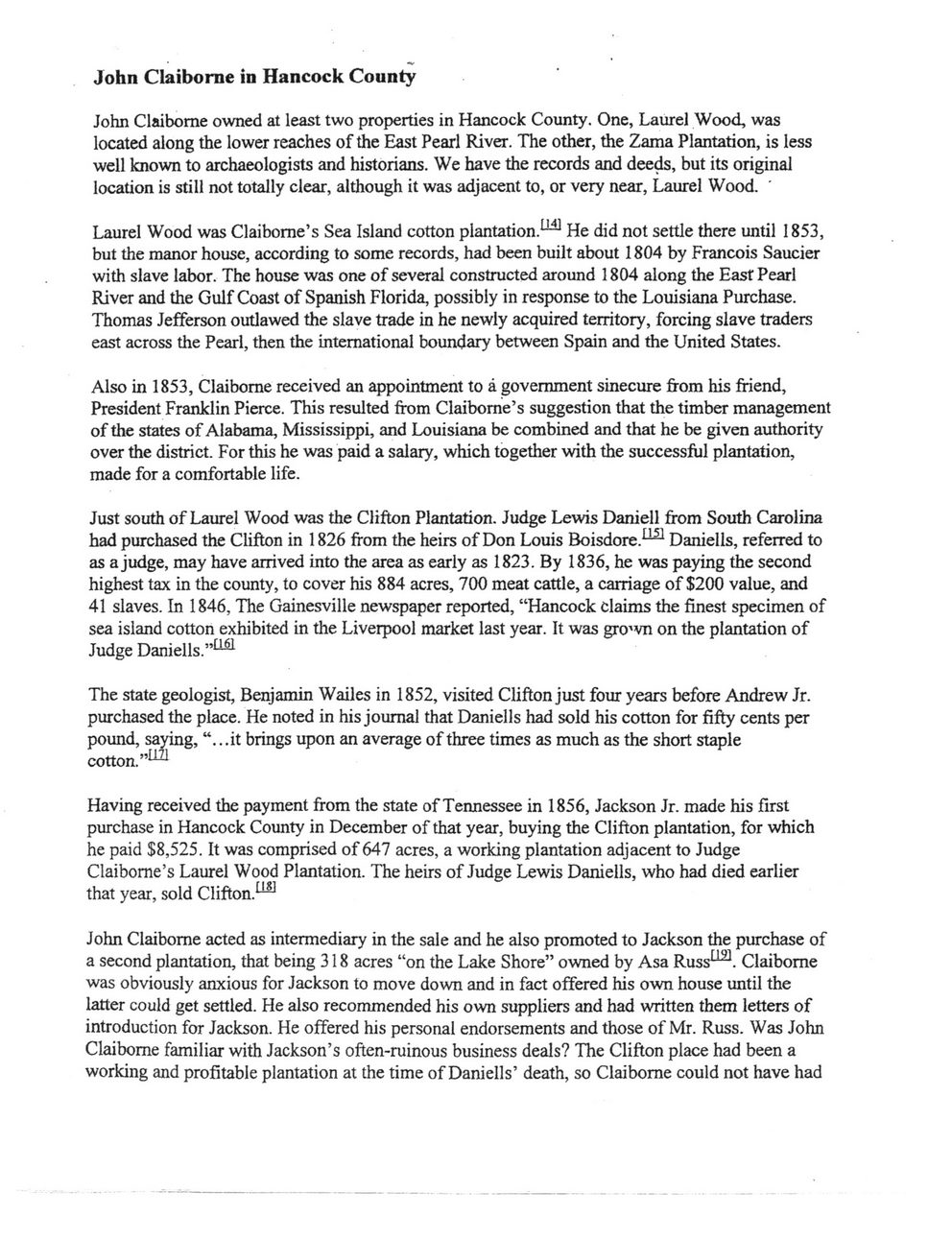This text was obtained via automated optical character recognition.
It has not been edited and may therefore contain several errors.
John Claiborne in Hancock County John Claiborne owned at least two properties in Hancock County. One, Laurel Wood, was located along the lower reaches of the East Pearl River. The other, the Zama Plantation, is less well known to archaeologists and historians. We have the records and deeds, but its original location is still not totally clear, although it was adjacent to, or very near, Laurel Wood. Laurel Wood was Claiborne?s Sea Island cotton plantation.11^ He did not settle there until 1853, but the manor house, according to some records, had been built about 1804 by Francois Saucier with slave labor. The house was one of several constructed around 1804 along the East Pearl River and the Gulf Coast of Spanish Florida, possibly in response to the Louisiana Purchase. Thomas Jefferson outlawed the slave trade in he newly acquired territory, forcing slave traders east across the Pearl, then the international boundary between Spain and the United States. Also in 1853, Claiborne received an appointment to a government sinecure from his friend, President Franklin Pierce. This resulted from Claiborne?s suggestion that the timber management of the states of Alabama, Mississippi, and Louisiana be combined and that he be given authority over the district. For this he was paid a salary, which together with the successful plantation, made for a comfortable life. Just south of Laurel Wood was the Clifton Plantation. Judge Lewis Daniell from South Carolina had purchased the Clifton in 1826 from the heirs of Don Louis Boisdore.0^ Daniells, referred to as a judge, may have arrived into the area as early as 1823. By 1836, he was paying the second highest tax in the county, to cover his 884 acres, 700 meat cattle, a carriage of $200 value, and 41 slaves. In 1846, The Gainesville newspaper reported, ?Hancock claims the finest specimen of sea island cotton exhibited in the Liverpool market last year. It was gro'vn on the plantation of Judge Daniells.?^ The state geologist, Benjamin Wailes in 1852, visited Clifton just four years before Andrew Jr. purchased the place. He noted in his journal that Daniells had sold his cotton for fifty cents per pound, saying, . .it brings upon an average of three times as much as the short staple cotton.?1121 Having received the payment from the state of Tennessee in 1856, Jackson Jr. made his first purchase in Hancock County in December of that year, buying the Clifton plantation, for which he paid $8,525. It was comprised of 647 acres, a working plantation adjacent to Judge Claiborne?s Laurel Wood Plantation. The heirs of Judge Lewis Daniells, who had died earlier that year, sold Clifton.^ John Claiborne acted as intermediary in the sale and he also promoted to Jackson the purchase of a second plantation, that being 318 acres ?on the Lake Shore? owned by Asa Russ^. Claiborne was obviously anxious for Jackson to move down and in fact offered his own house until the latter could get settled. He also recommended his own suppliers and had written them letters of introduction for Jackson. He offered his personal endorsements and those of Mr. Russ. Was John Claiborne familiar with Jackson?s often-ruinous business deals? The Clifton place had been a working and profitable plantation at the time of Daniells? death, so Claiborne could not have had

Claiborne, J.F.H Claiborne-J.F.H-002